The Awl Turns Two
by The Awl
Oh, so, yeah, hey, The Awl turns two today. We’ve got big plans for the next year and beyond, but right at this moment we’d like to take the time to acknowledge everyone out there who has contributed, offered words of encouragement, or mentioned the site to a friend. (We would also like to take the time to take a nap, because we have felt every minute of these two years, but that’s probably not part of the deal.) We could not have done it without you, and we appreciate that. Thanks.
The 'Cabinet' Benefit: Support Your Great Local Publication
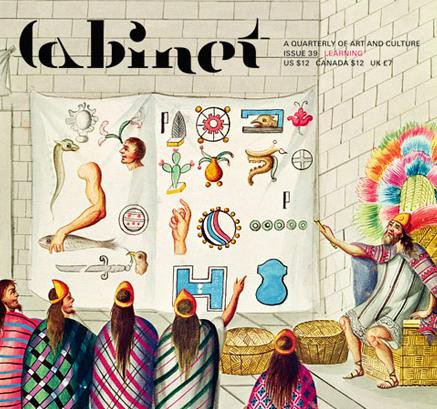
You know how benefits are stuffy and boring, and there’s stupid table seating, and terrible food, and people you don’t like, and then there’s speeches about how awesome someone is that you don’t care about? Not at this benefit! It’s the Spring 2011 benefit for Cabinet magazine, which is both a non-profit and everyone’s favorite mag. The thorougly unstuffy event is next weekend, in Brooklyn, and features local hottie/crazy and HBO auteur Jonathan Ames and “pickpocketing and close-up magic,” and also alcohol. Tickets are cheap, as these things go, and they’re also tax-deductible, and as it’s two days after tax day, I know you are thinking about tax deductions.
True Stories About Ann Dunham
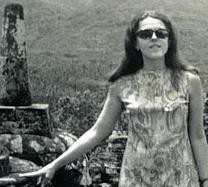
Here is a small bit of Janny Scott’s biography of Barack Obama’s mother, detailing in particular the years they lived in Indonesia with her second husband. Born in 1942, having her first child in 1961, and moving to Jakarta in 1967 — which set the stage for her to become an early expert in the more recently trendy world of global microfinancing — it reveals yet again that the women of this generation lived incredible lives in an incredible time, a fact that’s often covered-up by (at least) the passage of decades. To me, the story most notably shows the value of following your interests and passions — moving from anthropology to teaching English and crafts to lecturing on economics and advising banks and foundations actually is a straightforward career path, but only in retrospect.
Some Thoughts On Spitting In The Street
“A few centuries ago spitting in the street was as normal as tipping your chamber pot out of the window. Today ‘flobbing’ or ‘gobbing’ as it’s colloquially known, is considered by many to be ugly, anti-social and potentially disease spreading. And yet it’s a taboo that is regularly broken by people with a mouthful of phlegm.”
Local Man from American Falls Turns Against Republicans

Good morning, have you read your local paper? Today’s small-town American newspaper: The Aberdeen Times and the Power County Press, which share both a website and adjacency to Idaho’s Craters of the Moon national monument. Their top story today: Pigeon poo presents perplexing problem for A.F. City Council. Oh yes, Aberdeen’s neighbor, American Falls, is in trouble:
An overabundance of pigeons leaving their calling card on buildings and sidewalks in downtown American Falls led to a slightly humorous, but serious discussion at the American Falls City Council meeting Wednesday, April 6.
Several citizens voiced their willingness to use their shotguns to help with the pigeon problem on Idaho Street. However, American Falls Chief of Police Brandon Wilkinson vetoed that idea.
Also? There is a noteworthy letter to the editor….
To the editor,
I became so frustrated with the actions of the Republican Party during this last session, that I considered changing my status to that of an Independent. But after reconsideration and the legislature’s overturning of the state’s open primary system, I think I will stay registered as a Republican, so I can vote the “lunatics” out of office.
You can subscribe to the weekly paper for $30 in-state, $35 out-of-state or $27 locally for a year. It’s a bargain actually!
The Perplexing Final Chapter Of San Francisco's Jejune Institute
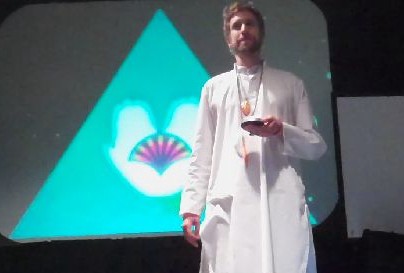
The email came with the subject line “SEMINAR ((nfltr8)).” It purported to be from a group called the EPWA, a grassroots guerrilla group dedicated to overthrowing the Jejune Institute, an evil group of free-love pseudo-scientists who’ve been vying for control of San Franciscan minds since 1972. The email told me to report to the Institute’s temporary offices in the Hyatt at the Embarcadero. There I was to swipe some mysterious objects called “BIOTIC-4CE GLOBES,” which I would find in a screening room. This task, the email said, was of the utmost importance. It was time to take down the horrific Jejune Institute once and for all.
So began the last act of what has been one of San Francisco’s greatest secrets, an underground alternate reality game/public-art installation that, over its three years of existence, has drawn more than 7,000 participants, most of them introduced to the project by word of mouth. Now, on this April weekend, the elaborate, multidimensional project, organized by a group called Nonchalance, was coming to a close.
I reported to Suite 1140 as directed. There I was greeted by an “Institute member” — think stereotypical hippie with white robes, necklaces and bracelets (or, if you like terrible music, think The Polyphonic Spree) — who ushered me into a heavily curtained, candle-lit, ethereal-music-ed waiting room. Seven other players were already seated there, sitting in awkward but alert semi-silence as they observed the interactions of the Institute’s “staff.”
Every ten minutes, a door to the back room opened and a lone player would walk out. Their faces showed confusion and apprehension. They’d quickly snatch their coat from the floor pile and scurry out. A tall doctor with psyche-piercing eyes and a Cosmo Kramer-esque mane would follow the player’s exit and, clipboard in hand, ask the remaining assembly “Who’s next?” After nearly an hour, I was.
I followed him to a room.
“Have a seat,” he said. “I’ll be back in 30 seconds.”
He ducked out. The room was called “a pre-screening room”; in reality, it was a fairly standard hotel room with some extra lighting arrangements and audio/video setups. I opened the drawer next to me, on the hunt for BIOTIC-4CE GLOBES. Empty. I ran across the room — in the next room I could hear the doctor shuffling papers — and searched another drawer. Nothing. And then I saw, in clear view on the table, a bowl of small “globes.” They looked, I noticed, a lot like flowering tea balls. I snatched one, hid it in my pocket, and got back to my seat just as the doctor returned.
The brainwashing began. The doctor strapped on headphones, hooked up a few meters, “calibrated the machine,” and told me to watch the video, an updated version of the montage from The Parallax View. When it ended, the doctor stared at me for an awkward few moments to judge whether or not the video had “taken.” He jotted down some notes and then broke his silence to issue a final verdict: “We’re all set here then. We’ll see you back here tomorrow.”
In less than 24 hours was the weekend’s main event: Socio-Reengineering Seminar 2011.
***
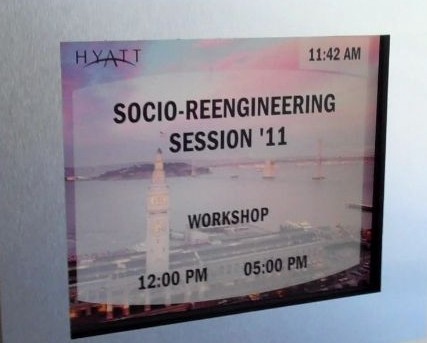
A sure-to-be-incomplete recollection of the various exercises that the 250 participants (including a dozen or so actors) took part in during the Jejune Institute’s final five-hour-plus event, A Socio-Reengineering Seminar, held April 10th, in the Garden Room of the Hyatt Regency in the Embarcadero:
• Being given a bracelet with a crystal hinted to have magical properties.
• Watching a video of a dolphin “telling jokes.”
• Taking off a shoe, throwing it into a pile, choosing someone else’s, creating a story about the foreign shoe, locating the owner and relaying that story.
• Pairing up with a stranger, one instructed to yell “Yes!” while the other responded with variations of “No!”
• Pairing up with another stranger, sitting across from them, and telling them “who you are” without interruption while the listener sat in stone silence.
• Writing in stream-of-consciousness prose about a perfect day taking place one year in the future.
• Conducting small-talk while milling around the room, as if in a giant party, trying to stay equidistant between two self-chosen “marks.”
• Lying under a parachute with 50 others, in extended meditative silence with eyes closed.
• Tribal-ish dancing.
• Finding a spot on the ground, lying in a fetal position, and being led in a series of breathing exercises.
In other words, exactly the type of activities you’d expect to engage in during a meditative/team-building retreat put on by a collective of radical hippie scientists from the ‘70s.

I feel safe saying that, for the majority of players, when we’d arrived at the seminar these exercises seemed mere preamble. Following the instructions of the EPWA email, we had cast ourselves in the roles of infiltrators, not actual Jejune members who believed in this shit. (Imagine if every member of the People’s Temple was really an FBI plant waiting to take down Jim Jones.) Whenever we were prompted to pair up with a stranger, a knowing look would pass between us, a look that signaled detachment from the day’s events — a look that said, “we’re not really doing this for real.”
Four hours later and we weren’t so sure.
“I’m curious as to when we use these balls,” a new friend said to me during the ‘tell me who you are’ exercise. The two of us had chosen to forgo baring our souls in favor of trying to covertly pass information about the impending confrontation — surely, something big was going to happen soon. A real game-changer. Looking around, you could tell this feeling was a common one. Everyone was on edge, hands in pockets, clutching their globes. We waited expectantly. When was the final battle going to start? When was all this hippie build-up going to lead to something?
Following a break, we were given glasses of hot water and told to sit. The seminar’s featured speaker “Antoine Logan” had something important to tell us.
“Some of you brought something with you,” Logan said. “It might be in your pocket, or secreted in a fold in a garment. You would have brought it hidden. You know what I’m talking about.”
Everyone tensed. How did he know? The signal was to be given by a member of the EPWA, not by the main delegate of Jejune. If your mom ever told you to get rid of your hidden porn stash, you know the feeling we were experiencing. Do you deny and hope she’s just bluffing? Even though you know she knows?
“What’s the right thing to do?” Logan continued. “I want to look around me to see what’s okay here. Take out what you brought with you, and when you’re ready, put it in the water.”
“Why?” someone shout-asked, frustrated with the sudden turn.
“Because that’s how we make tea.”
A burst of laughter at the obviousness of this statement led to the slow realization that, well, this was it? We’re using these flowering tea balls not as weapons but… to make tea? After three years of game-playing, not to mention today’s five-hour seminar, this was how it was to end? The fourth wall broken, no plot resolution, no final battle, no climax? Just a day-long celebration of peace, love, all that bullshit?
WAS THIS IT???
The tea was followed by a cameo from Octavio Coleman, the Terence Stamp-looking guy from the indoctrination video. Fast-forward to about 8:30 in the video and you can feel the hesitancy and confusion people felt as they wondered how to react to the ending.
A mood of discontent became palpable in the room. The first twenty minutes of the impromptu post-game Q&A; with Jeff Hull, the game’s creator, was variations of fans in full Comic Book Guy-mode asking, “Is that it?” A thread at UnFiction began filling with posts beginning with “count me among the disappointed.” Someone even made the ultimate symbol of disapproval: A Downfall parody video.
***
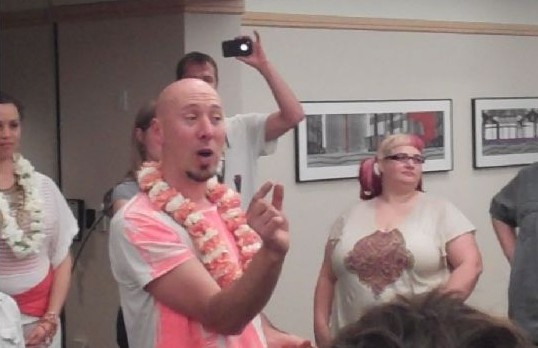
“I wanted people to feel the same uncomfortable feeling they did in the original room,” explained Hull during a later, less contentious portion of the Q&A.; It took me a few days to appreciate his accomplishment.
By hinting that the game’s elaborate plot was going to be resolved, the die-hard players were drawn to attend. Had they known before the seminar started that it was going to be five hours of dancing hippies, it’s doubtful they would have shown up so eagerly. (I, for one, probably would’ve sat this one out.) But with the plot unresolved — or, for that matter, even addressed — a tension was created, one that shifted the question of the day from “When are we getting to the good stuff?” to “Is this real?”
(The flip side of this, obviously, is that not ending the plot was as big of a cop out as “It was all a dream.” Or, you know, the ending of “Lost.”)
The game already had layers of distancing built into its play: The gamers are playing the roles of people infiltrating the Institute, which is in turn staffed by actors who are themselves playing roles. The actors know that we know that they’re actors, meaning we know that they know we’re infiltrators, and so on — but at what point do these layers blend and break down and become one great big ball of reality? If I’m dancing around like a maniac but still keeping my mental distance, am I not still dancing around like a maniac?
During the Q&A;, Hull said that one of his inspirations is the Museum of Jurassic Technology in Los Angeles, a magical little place in a strip mall that no one’s still quite sure what to make of. Lawrence Weschler wrote an entire book without ever getting to the bottom of it. In it, he talks about a “sense of slippage,” of not knowing where the line of reality is drawn. It doesn’t help that David Wilson, the museum’s creator, never signals his intention in interviews. He never winks, never satisfies our desire to confirm that we get it — that we’re in on the joke.
In a somewhat-apologetic post — an explanation that had me in a 24-hour long thought-spiral obsessing about the art vs. the artist’s intentions, how much they should be taken into account, if Spielberg or faulty technology should get credit for Jaws, if Ty Cobb should be the Hall, if someone watching A Birth of a Nation without knowing its history should be faulted for admiring it, and on and on until, naturally, I ended up with a terrible hangover — Hull addresses this issue:
Where does the fantasy begin and end? What is the real role of the player, performer, and producer? Now what??? We were actively challenged by these questions, and this was the “conflict” we attempted to resolve. The pressure between Antoine Logan and the audience during the tea ceremony, and the dead silence of the room after Octavio’s address reflected that tension.
It’s that moment of “slippage,” of not being sure what’s real and what’s fake. Or if it’s even over. There’s no safe place. It’s Andy Kaufman staying in character. It’s a wrestler’s “kayfabe.” It’s going through a haunted house, knowing that you’re actually paying people to scare you, but, you know, that knife sure does like sharp, and wouldn’t this just be the perfect place for a real psychotic to hide? And isn’t that uncertainty the point?
Rick Paulas is a writer living in Los Angeles.
The Skorpion Show On Beyonce's New Single 'Girls (Who Run The World)'
When something as significant as the release of Beyoncé’s first new single in two years happens, everyone on the internet seems to feel the need to share their opinions and expert criticisms, this website included. But as we racked our brains trying to figure out what to do for it, this video review by The Skorpion Show crossed our paths and articulated everything and anything we would ever hope to say, but better and more sincerely than we ever could. It should also be noted that this video is a response to the demo version of the song that leaked yesterday, and not the official version that came out today.
UPDATE: The show is liveblogged in the comments below!
Geoff Dyer On Reading And Writing
“Again to talk about actuarial norms, it really is the case that as you get older you read less fiction. And then by the time you are my age, it’s really quite minimal the amount of fiction that one reads. As I’ve joked before, the next stage along that path is that you only read military history. I’m kind of looking forward to that.”
— Here’s an enjoyable interview with author Geoff Dyer, whose But Beautiful has a special place in my library. I can still recall certain lines by heart, like this bit from the Lester Young story: “He ate almost nothing, but he still had his preferences when it came to food: Chinese was his favorite, that was the food he didn’t eat most of.” Anyway, read that book and read this interview. I mean, only if you feel like it, I can’t force you to make the most out of life.
It's Science! And Brian Eno!
Brian Eno, “Glitch” (taken from Drums Between The Bells) by Warp Records
There is something that seems impossibly unfair about brilliant scientists who also manage to be wonderful writers. Like, okay, it’s not enough that you’re a theoretical physicist, you also happen to turn out remarkable Borgesian tales. Grrr! I had the same feeling about David Eagleman, whose Sum was reviewed (accurately) in the New York Times as a “delightful, thought-provoking little collection [which] belongs to that category of strange, unclassifiable books that will haunt the reader long after the last page has been turned.” Eagleman is profiled in this week’s New Yorker, which discusses his research into our perceptions of time. I was humming along and enjoying it, almost fully able to set aside my feelings of insecurity, until I got to the part where, hey, he gets to go over to Brian Eno’s studio to perform an experiment on a bunch of drummers. Okay, it’s not enough that you’re a neuroscientist whose work is “full of touching moments and glorious wit,” but you also happen to hang out with Brian Eno. Grrr! (You should still read this piece.) Speaking of Brian Eno, he’s got a new record out in July which is a collaboration with the poet Rick Holland. You’ll find the track “Glitch” above. It may not be to everyone’s taste, but it is certainly to mine.
Robot Wants Kitty = Two Hours of Brain Candy
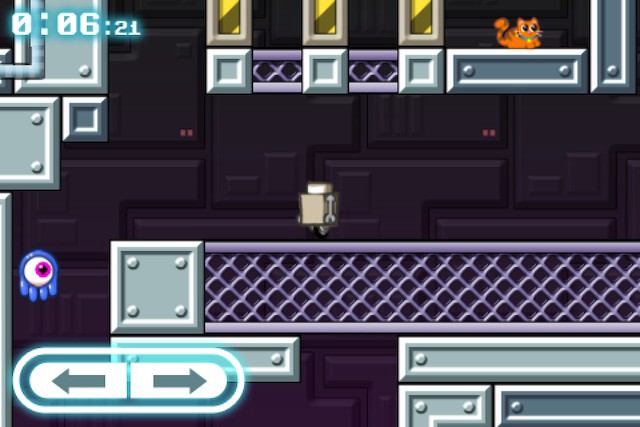
It’s rare when we bring you news from the casual game world, so you know it’s important when we do: Robot Wants Kitty is now an iPhone game. And really quite well done! It’s a little short overall, but, you know, it’s 99 cents! I would pay that much to help a robot find a kitten. (The original flash game series begins here.)
